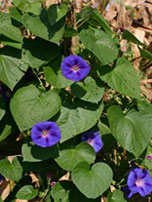Kakanjani

Botanical Name : Ipomoea purpurea
Family : Convolvulaceae
Introduction :
Purple morning glory is a species in the genus Ipomoea family. It is native to Mexico and Central America. Like all morning glories the plant entwines itself around structures. It grows up to a height of 2–3 m tall.
Names in different Indian languages :
Kannada : Gowri beeja, Kolli beeja
Hindi : Jharmaric
Malayalam : Taliyari
Tamil : Kakkattan, Kotikkakkattan
Telugu : Kollivittulu, Jiriki, kolli
Sanskrit : Kakanjani
English : Blue Morning Glory
Properties :
Dravya
Rasa
Katu (Pungent), Madhura (Sweet)
Guna
Laghu (Light), Ruksha (Dry), Tikshna (Sharp)
Veerya
Ushna (Hot)
Vipaka
Katu (Pungent)
Morphology :
Leaf
The leaves are divided into 3-6 toothed leaflets, with smaller leaflets in between
Flower
4–6 cm Red–violet–blue 5 Blade widely cordate, sometimes 3-lobed, with entire margin, base deeply lobed
Fruit
7–10 mm (0.28–0.4 in.) long pome Fruiting time is July–August With hooked hairs
Karma :
Kapha, Vata
Parts Used :
Leaves, Flowers.
Chemical Composition :
The seeds of Ipomoea violacea contain about 0.1% ergot alkaloids, including ergotmetrine, chanoclavine and lysergol
Uses :
Oedema, Oliguria, Ascariasia, Constipation, Mental disorders, Blotches, Pimples, Diarrhea, Sore throats